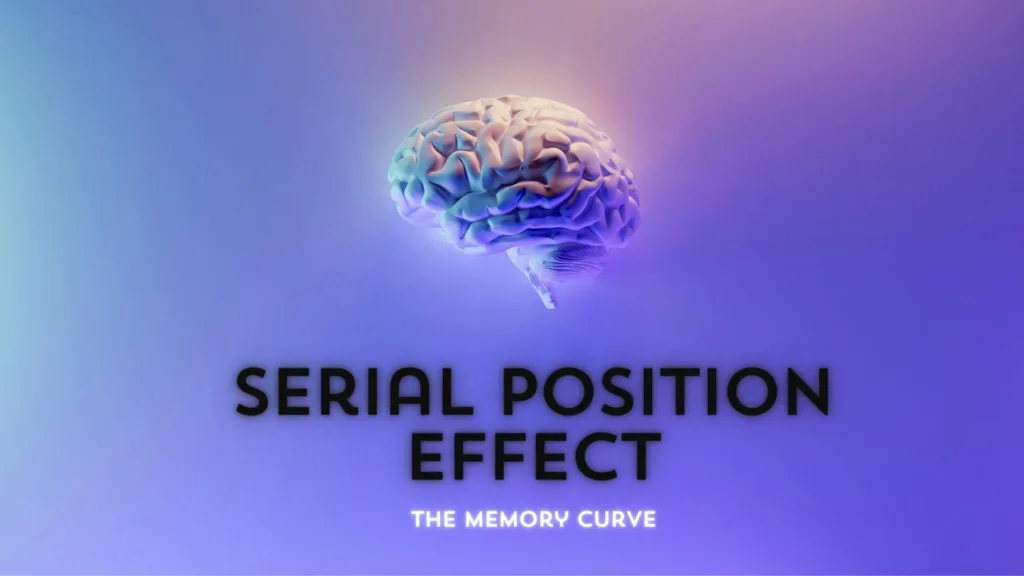Inside our minds, there’s a cool thing called the Serial Position Effect. It’s like a secret code that helps us figure out how memory and thinking work. Scientists have looked into it to understand how we remember stuff when it’s given to us in a list. It’s not just about remembering lists; it’s about how our brains keep and bring back memories, which is important for everything we do, from easy stuff to thinking hard.
Understanding the Serial Position Effect:
The Serial Position Effect is when people remember things differently based on where they are in a list. Imagine you have a list of words to remember, like “apple, banana, cherry, date, eggplant”. You might remember the first few words (like “apple” and “banana”) well because they’re at the beginning of the list. That’s called the “primacy effect.” Then, you might also remember the last few words (like “date” and “eggplant”) well because they’re at the end. That’s called the “recency effect.”
This idea was first noticed by a scientist named Hermann Ebbinghaus a long time ago when he was studying memory. He found this by doing tests where he made up nonsense words and asked people to remember them in a certain order.
But this isn’t just about remembering lists. It’s about how our brains work when we try to remember things in general. It’s like when you try to remember a story or a list of chores, your brain might remember the beginning and end better than the middle parts. This Serial Position Effect helps us understand how our memory works in lots of different situations, not just memorizing boring lists.
Parts of Serial Position Effect
The Serial Position Effect has two important parts: the primacy effect and the recency effect. Let’s break it down:
- Primacy Effect: This is when we remember things at the beginning of a list better. For example, if someone gives you a list of animals like “dog, cat, bird, fish,”. You might remember “dog” and “cat” really well because they’re at the start. This happens because our brains get more time to really remember these items since they come first.
- Recency Effect: This is when we remember things at the end of a list better. So, going back to our list of animals, you might also remember “bird” and “fish” well because they’re at the end. This happens because these items are still fresh in our minds since they were just heard, like when you’re playing a game of “remember the words” with friends.

Practical Implications
Here are some practical ways the Serial Position Effect can make life easier:
- Learning Better: Teachers can help students remember important stuff by putting it at the beginning and end of lessons. So, if you’re learning something new, you’ll likely remember it better if it’s talked about first and last.
- Remembering Ads: Advertisers can make ads more memorable by putting the most important parts at the beginning or end. That way, you’re more likely to remember their message when you’re deciding what to buy.
- Giving Presentations: If you’re giving a talk or presentation, it helps to start and finish with the most important points. This way, your audience is more likely to remember what you said.
- Remembering Stuff: When you’re trying to remember a bunch of things, like a shopping list, focusing on the first and last items can help. So, if you need to remember to buy apples, bananas, and oranges, you’ll likely remember them better if you think about them first and last.
- Using Apps and Websites: Designers of apps and websites can make them easier to use by putting important buttons or features at the beginning and end of menus.
Related Article: Flashbulb Memory: Photographs of the Mind
Factors Influencing the Serial Position Effect
- List Length: If there are a lot of things on the list, it’s easier to see the Serial Position Effect in action. You’ll really notice that you remember the first and last things best.
- How Fast Things Are Shown: If the items on the list are shown or said really quickly, it might be harder to remember any of them well.
- Distractions: If there’s a lot of noise or other stuff going on while you’re trying to remember a list, it might mess up how well you remember each thing.
- Personal Differences: Everyone’s memory works a bit differently. Some people might be better at remembering the start of a list, while others might be better at the end.
- How Important Things Are to You: If the stuff on the list is really important or interesting to you personally, you’ll probably remember it better, no matter where it falls in the list.
- How Hard the Things Are to Remember: If the things on the list are really complicated or need a lot of thinking, it might affect how well you remember them in relation to where they are on the list.
As we explore more about how our brains work, the Serial Position Effect shows us just how tricky memory can be. Understanding this effect helps us see how our minds store and remember things, which can be really complicated. It’s like solving a puzzle about how our brains think and remember stuff, which is a big part of psychology and thinking.

Pingback: State Dependent Memory: How Our Mood Shapes Memory